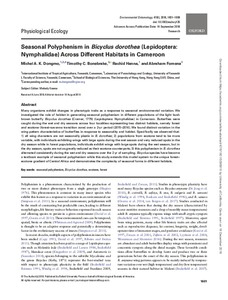| dc.contributor.author | Dongmo, M.A.K. |
| dc.contributor.author | Bonebrake, T.C. |
| dc.contributor.author | Hanna, R. |
| dc.contributor.author | Fomena, A. |
| dc.date.accessioned | 2019-12-04T11:30:06Z |
| dc.date.available | 2019-12-04T11:30:06Z |
| dc.date.issued | 2018-12-07 |
| dc.identifier.citation | Dongmo, M.A., Bonebrake, T.C., Hanna, R. & Fomena, A. (2018). Seasonal Polyphenism in Bicyclus dorothea (Lepidoptera: Nymphalidae) Across Different Habitats in Cameroon. Environmental Entomology, 47(6), 1601-1608. |
| dc.identifier.issn | 0046-225X |
| dc.identifier.uri | https://hdl.handle.net/20.500.12478/5192 |
| dc.description | Open Access Article; Published online: 14 Sept 2018 |
| dc.description.abstract | Many organisms exhibit changes in phenotypic traits as a response to seasonal environmental variation. We investigated the role of habitat in generating seasonal polyphenism in different populations of the light bush brown butterfly Bicyclus dorothea (Cramer, 1779) (Lepidoptera: Nymphalidae) in Cameroon. Butterflies were caught during the wet and dry seasons across four localities representing two distinct habitats, namely forest and ecotone (forest–savanna transition zone) over a 2-yr period (2015–2016). We found distinct variation in the wing pattern characteristics of butterflies in response to seasonality and habitat. Specifically we observed that: 1) all wing characters are not seasonally plastic in B. dorothea; 2) populations from ecotone tend to be more variable, with individuals exhibiting wings with large spots during the wet season and very reduced spots in the dry season while in forest populations, individuals exhibit wings with large spots during the wet season, but in the dry season, spots are not as greatly reduced as their ecotone counterparts; 3) this polyphenism in B. dorothea alternated consistently during the wet and dry seasons over the 2 yr of sampling. Bicyclus species have become a textbook example of seasonal polyphenism while this study extends this model system to the unique forest–ecotone gradient of Central Africa and demonstrates the complexity of seasonal forms in different habitats. |
| dc.description.sponsorship | National Science Foundation |
| dc.format.extent | 1601–1608 |
| dc.language.iso | en |
| dc.rights | CC-BY-4.0 |
| dc.subject | Ecotone |
| dc.subject | Forests |
| dc.subject | Nymphalidae |
| dc.subject | Cameroon |
| dc.subject | Polyphenols |
| dc.title | Seasonal polyphenism in Bicyclus dorothea (Lepidoptera: Nymphalidae) across different habitats in Cameroon |
| dc.type | Journal Article |
| dc.description.version | Peer Review |
| cg.contributor.crp | Roots, Tubers and Bananas |
| cg.contributor.affiliation | International Institute of Tropical Agriculture |
| cg.contributor.affiliation | The University of Hong Kong |
| cg.contributor.affiliation | University of Yaoundé |
| cg.coverage.region | Africa |
| cg.coverage.region | Central Africa |
| cg.coverage.country | Cameroon |
| cg.creator.identifier | Rachid Hanna: 0000-0002-5715-0144 |
| cg.isijournal | ISI Journal |
| cg.authorship.types | CGIAR and developing country institute |
| cg.iitasubject | Pests Of Plants |
| cg.journal | Environmental Entomology |
| cg.howpublished | Formally Published |
| cg.accessibilitystatus | Open Access |
| local.dspaceid | 102818 |
| cg.targetaudience | Scientists |
| cg.identifier.doi | https://dx.doi.org/10.1093/ee/nvy135 |

